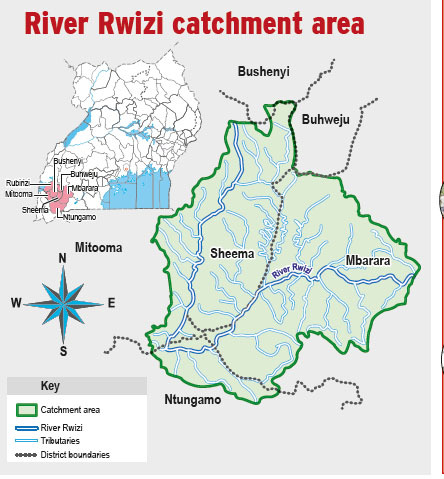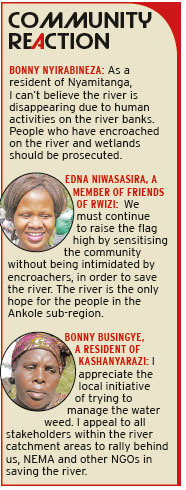Water hyacinth threatens River Rwizi
Sep 30, 2020

ENVIRONMENT
The future of River Rwizi, which is a major water source for domestic, commercial and agricultural needs for millions of people in the Ankole sub-region is under threat if the Government does not change the tide to reverse the current levels of degradation. But degradation is not the only challenge.
Urgent action is needed to save it, as well, from the jaws of the water hyacinth. Jeconius Musingwire, the southwestern region National Environment Management Authority (NEMA) manager, attributed the cause of the degradation to poor agricultural practices.
He said the hyacinth has further congested the river catchment from Ndeija sub-county in Rwampara district up to Sango bay in Rakai district. The river originates from Buhweju hills, with various tributaries from Nkore hills, including Ntungamo and Sheema. It pours its water into Lake Victoria via the drainage systems of Lake Mburo, Lake Kachera and Lake Kijanebalola.
EFFECT OF ENCROACHMENT AND RESTORATION
The river, which covers approximately 8,200km in the districts of Mbarara, Kiruhura, Lyantonde, Rakai, Isingiro, Rwampara, Lwengo, Bushenyi, Buhweju, Sheema, Rubirizi and Mbarara. The river water has been contaminated, turning brown when it rains due to human activities on its banks.
Musingwire said people have illegally acquired over 500 hectares of land on the banks of the river, destroying wetlands.

"NEMA and the water and environment ministry are not keeping quiet on the restoration and management of the river. "We have been lobbying for partners and we have got two, Nile Breweries and ACODE (Advocates Coalition for Development and Environment). I call for collective efforts to save the river from drying up," he says.
Musingwire explains that ACODE is handling the Bujaga sub-catchment, which covers Bugamba and Ndeija sub-counties while Nile Breweries is handling Kakigani sub-catchment, covering Kakigani and Nyeihanga town council in Rwampara district.
NEMA, NGOS CLASH WITH LOCAL LEADERS
River Rwizi became a victim of the invasion of the water hyacinth in the early 2000s. Although efforts were made to fi ght the dangerous weed on other water bodies, such as Lake Victoria and Lake Kyoga, the fight on River Rwizi came a little late.
The hyacinth has now covered the remaining part of the water surface, and Nyamitanga leaders also hired local divers and removed the weed in Kitebero and Nyamitanga. Moses Karanzi Kajubi, the Mbarara South City interim mayor, said they introduced the initiative because they were not getting action from NEMA.

Musingwire criticised the effort, which discouraged the leadership. "Local government has no affecting aquatic life. In an effort to clear the river of the weed, a confict has erupted, between NEMA and non-governmental organisations on one side and local leaders from Mbarara on the other.Musingwire said NEMA has not got any funds for the removal of the weed, but has written a number of proposals to get funds from the central government.
Last year, local leaders in Mbarara, in partnership with NGOs, came up with an initiative of locally removing the water weed from the river using local divers and rudimentary tools.
However, the method was mocked by the NEMA officials. This year, again, a team of Mbarara City Development Forum, led by its president, James Turyagyenda Matama and Nyamitanga leaders also hired local divers and removed the weed in Kitebero and Nyamitanga. Moses Karanzi Kajubi, the Mbarara South City interim mayor, said they introduced the initiative because they were not getting action from NEMA.
Musingwire criticised the effort, which discouraged the leadership. "Local government has no funding for the management of the water weed, but we devised means to have our river and water source safe. However, we cannot manage the weed when the water ministry is not contributing to the cause," Kajubi said.
DAMAGE CAUSED
The TASO-Kitebero foot bridge that connects Kakoba to Nyamitanga is on the brink of collapse because of the effects of the weed.Tuyagyenda, said they intervened by employing local methods to remove the weed from the river, but they have no funds to support their cause.
Musingwire, however, said, though NEMA welcomes the initiative by the local leaders, let them be patient, until when funds are availed because their method is not sustainable. Ignatius Byaruhanga, the presidential adviser on environment in Ankole, said saving River Rwizi and other natural resources needs a combined effort from all stakeholders.
PREVIOUS EFFORTS TO SAVE RIVER RWIZI
In a bid to save River Rwizi, the Ministry of Water and Environment embarked on water retention interventions in upland catchment areas to save the river.
Water conservation structures, including earth and stone bunds, retention beaches, gabions and trenches were constructed in parts of Buhweju and Sheema, to increase water storage in the soil, so that water is available in wet and dry seasons.
Richard Musota, the principal water officer in the directorate of water resources management in the Ministry of Water and Environment, said the catchment loses 1,386 million cubic metres of rain water every year.
Musota said unless serious interventions and regulations of water fl ow are put in place by 2025, River Rwizi will be no more because there is much demand for water.In March this year, environment activist Geoffrey Walker Ayeni led a team of 14 walkers on an expedition covering 330km to create awareness about water and impacts of climate change.
The walk, flagged off by Archbishop of Church of Uganda Steven Kaziimba, was premised on saving River Rwizi. It started in Mabira, Buikwe district and ended in Mbarara, lasting 10 days.
